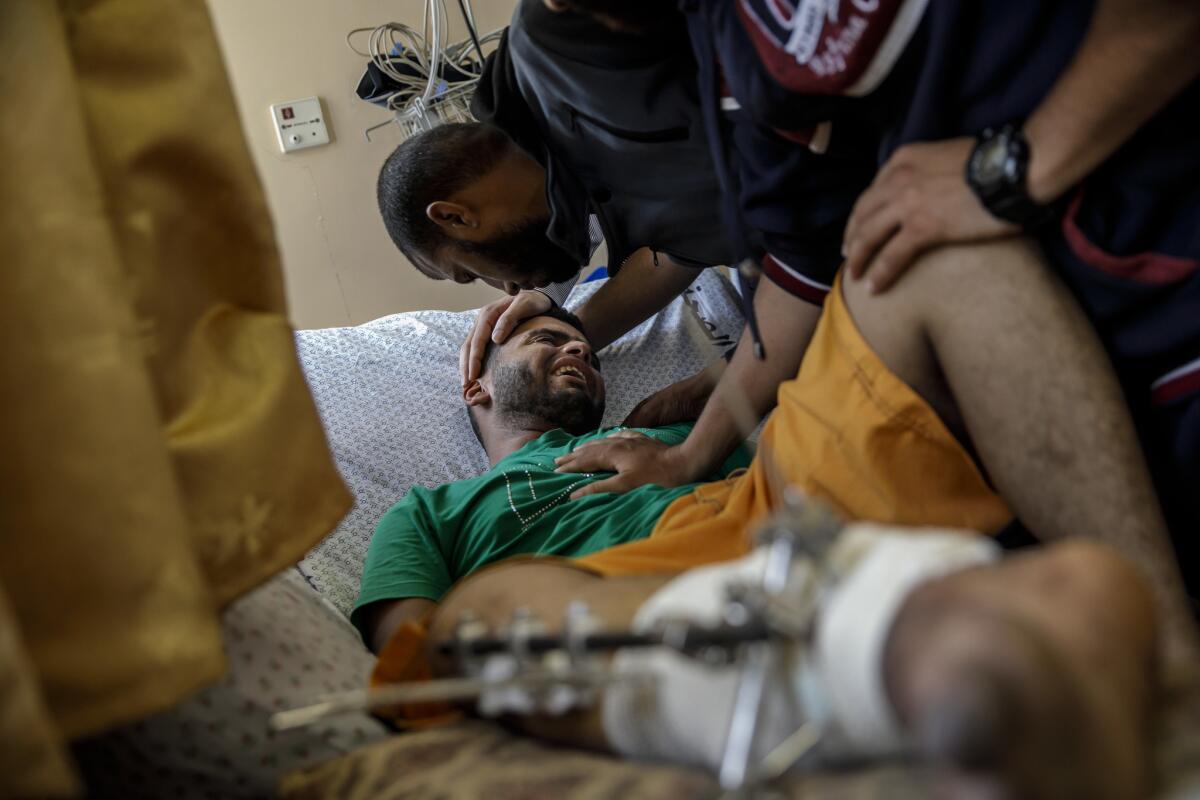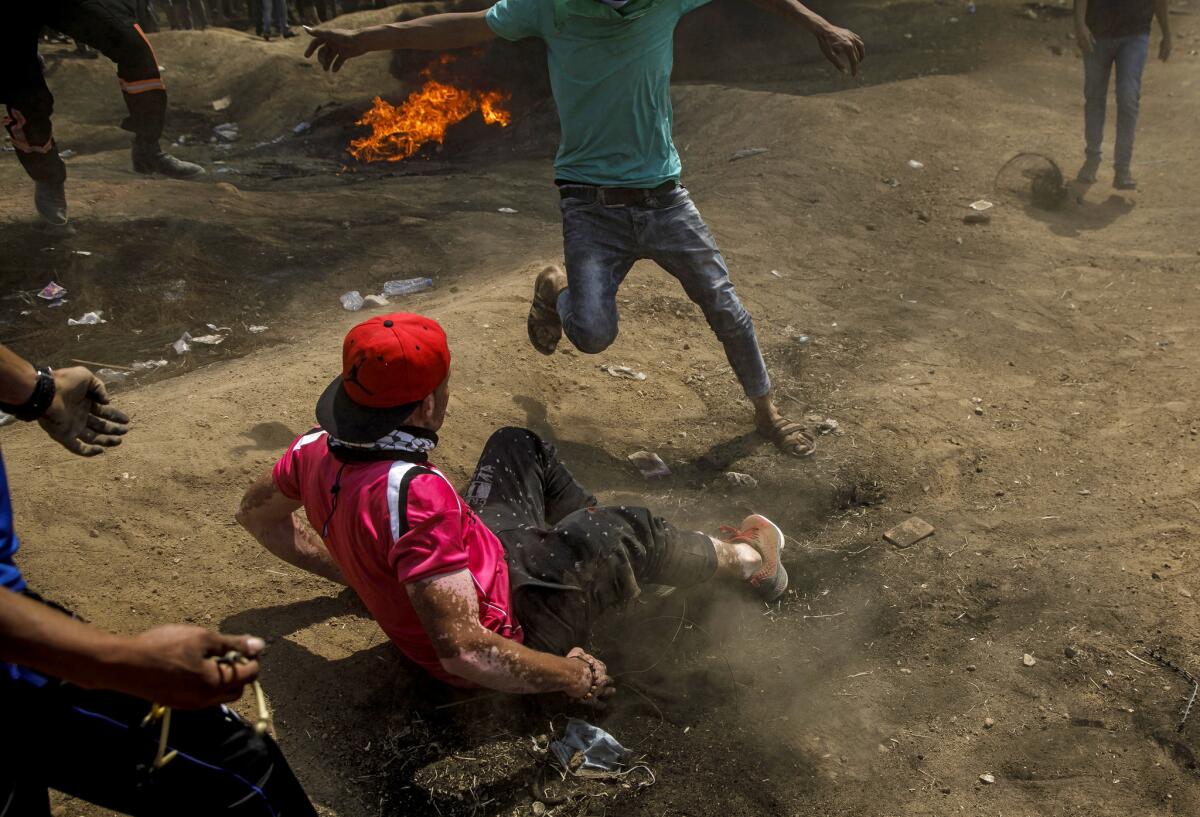Global Development: Israel shoots to wound, not kill. That has led to a wave of amputations in Gaza

- Share via
Baha Abu Ayash winced as a nurse unraveled the bandage around his right ankle. There was a whiff of rotting meat as a gaping bullet wound came into view. A doctor pinched his toes. They were black and cold.
For six days, the 23-year-old and his family had held out hope that his foot might be saved, if only he could be evacuated from the Gaza Strip. But it was too late now, the doctor from Jordan told them. Even if Israel agreed to the transfer, the decision would be the same.
“This patient needs a life-saving amputation,” the doctor said. “Gangrene has set in .… It is very critical.”
Still, the family hesitated. Nobody in the family had steady work. Who would support the young man if his foot or leg were removed?
“It’s not an easy decision,” said Mohammed Abu Ayash, one of his 12 siblings.
The toll of violence during two months of protests along the Gaza Strip’s border with Israel is most often measured in deaths: at least 127 Palestinians killed by Israeli gunfire.
But more than 14,000 have been wounded — 3,700 of them took bullets — according to the Palestinian Ministry of Health in Gaza. Nearly 60% of those gunshot casualties were hit in the legs — a strategy employed by the Israeli military to limit killings.
Doctors say many of these wounds are unusually severe and will require multiple surgeries and months of rehabilitation. In most cases, the patients will be left with life-long disabilities.
In Gaza, a 12-year-old amputee holds on to his dreams »
At least 28 people have lost limbs, a figure that the International Committee for the Red Cross says could triple — simply because the enclave’s hospitals are collapsing and do not have the ability to cope with the massive trauma load.
The wounded are not the only ones who will suffer.
Entire families depend on the injured, most of them young men in their 20s and early 30s. Many joined the protests because they already had lost hope of finding a job, getting married or building a future in this deeply impoverished enclave of 2 million people wedged between Israel, Egypt and the Mediterranean Sea.
“Now they are incapacitated,” said Marie-Elisabeth Ingres, head of mission for the French aid group Doctors Without Borders in the Palestinian territories. “What is the future for this new generation?”
Even before the current round of violence, Gaza’s hospitals were beset by chronic shortages of medicines, equipment and basic supplies, including dressings, antibiotics and painkillers.
Salaries for doctors and nurses have been slashed and sometimes go unpaid. With electricity available just a few hours a day, health facilities depend on generators that destroy their equipment.
The causes of the shortages are disputed.
Israel has imposed a stifling blockade on Gaza since 2007, when the armed Islamist group Hamas seized control from its secular rival Fatah. The Palestinian Authority, which is headquartered in the West Bank and run by Fatah, has also imposed retaliatory measures against the Hamas government in Gaza. But Israel accuses the militants of diverting funds for public services to military activities, an allegation Hamas denies.
The protests, held each Friday, have pushed the healthcare system to the brink. Hospital personnel compare the weekly influx of patients to what they experienced during the bombings of 2014, when Israel was at war with Hamas.
An estimated 1,350 protesters with complex injuries will each need three to five operations, the Red Cross said in a recent statement.
“Such a caseload would overwhelm any health system,” it said. “In Gaza, the situation is worsened by chronic shortages of drugs, equipment and electricity.”
With just 2,200 hospital beds in all of Gaza, health authorities ordered all elective surgeries canceled for the duration of the protests.
Even with no new injuries, the Red Cross estimates that up to 90 people will eventually need to be fitted with artificial limbs and 300 with other orthotic devices.
The Artificial Limbs and Polio Center, the only facility in Gaza that manufactures prostheses, is struggling to get the materials it will need. It recently had to stop production for nearly two months when Israel delayed a shipment of resin, a material that receives special attention from authorities because some types can also be used for military purposes.
The shipment finally arrived last month, but center officials say it won’t meet current needs.
Israeli military officials blame Gaza’s rulers for the mounting toll, accusing Hamas of using the protests as cover to try to break through security barriers and carry out attacks in Israel.
Non-lethal methods, such as rubber-coated bullets, have proved ineffective at deterring the crowds, Yoav Galant, a member of Israel’s Security Cabinet, recently told reporters. But he said the policy was to aim at demonstrators’ legs to minimize fatalities.
The severity of the injuries has raised questions in Gaza about the type of ammunition used. Israeli officials say soldiers employ only standard weaponry that complies with international laws.
The worst bloodshed occurred May 14, when the demonstrations reached a peak. Israeli forces unleashed barrages of tear gas and gunfire against crowds trying to break through the fence. Nearly 60 Palestinians were killed and more than 2,200 injured — 1,300 of them shot.
At Shifa Hospital in Gaza City, the strip’s largest, a triage tent was set up in the front courtyard. Pandemonium reigned.
Ambulances pulled up every few minutes with screaming, bloodied patients. Fistfights broke out between armed guards and panicked relatives, who jammed the hallways trying to find missing loved ones.
By 9:30 p.m., doctors had performed some 30 surgeries, sometimes working on two patients in the same operating theater. And there were more than 30 cases still waiting.
“I can’t find the words to describe the shortages we have here,” said Dr. Rami Hamdan, as he slumped into a chair to catch his breath in between surgeries.
In many cases, bullets had shattered bones, destroyed tissue and left large exit wounds. Hamdan said surgeons had to share the hospital’s only orthopedic drill.
“We clean and disinfect it, but we aren’t sterilizing it,” he said.
The sheer number of surgical cases was forcing doctors to make agonizing choices: spend hours repairing severed veins to try to restore blood flow to a limb, or quickly stanch the bleeding and move on to the next patient.
“Many of them, they tried up to exhaustion to save the limb,” said Ana Lucia Bueno, deputy health coordinator for the Red Cross in Gaza. “But they know that outside that room there are 10 more patients waiting for the operating theater … And of course the priority is always life.”
To make room for the next wave of casualties, the hospital is often forced to discharge patients early.

Wadieh Ras, 24, pleaded with staff not to kick him out. It had been just three days since he was shot in the leg at the fence east of Gaza City, and he had metal pins sticking out of his thigh and an exit wound the size of a fist. But his bed would be needed the next day.
Three relatives carried him yelling to the parking lot, where they had a car waiting to take him to a warren of narrow alleys and crumbling apartment blocks known as the “Beach” refugee camp.
Three days later, as he lay sweating and moaning in bed, ants crawled over his bandages, soaked through with blood and pus. His family decided not to wait for his next scheduled appointment at the hospital and took him to a Doctors Without Borders clinic.
The courtyard was jammed with young men with claw-like metal braces protruding from bandaged legs. Ras waited nearly four hours for an exam.
The wound was infected, the doctor told him. He would need antibiotics and daily dressing changes. There was also damage to the bones, muscles and veins.
He would need more surgeries.
The first hospital where Baha Abu Ayash was taken was full, so he was transferred to Shifa on the floor of an ambulance hauling two other wounded protesters. He lay on a gurney for hours, his family at his side.
“Maybe he would have had a chance if they dealt with him directly,” said his distraught mother, Rasmiya.
It was past midnight on May 15 — more than 11 hours since he’d been shot — when he was wheeled into surgery. Doctors worked on his ankle for more than three hours but could not say whether the operation was a success.
One said the leg was too severely damaged and would most likely have to be amputated. Others said there was a chance it could be saved.
Baha, stocky with a quick smile, once dreamed of becoming a lawyer. But there was no money for education after high school. The protests, called to demand the lifting of the blockade and a right to return to ancestral homes in what is now Israel, were an exciting distraction from the grinding poverty.
Baha said he was burning tires and carrying a Palestinian flag when he was shot near the fence in central Gaza. He and four brothers were regulars there.
“They go out of despair, because there is no money,” their mother said.
The close-knit family depends on a quarterly food package from the United Nations relief organization for Palestinian refugees. Rasmiya said she sold two bottles of oil from the last distribution to cover her taxi fare to the hospital.
She brought tubs of rice, chicken and hummus for Baha, because the hospital does not provide food. His brothers chipped in to buy pain medicine to help him sleep. But it didn’t seem to do much.
On the third day, when doctors proposed another operation, his older brother Mohammed, who the family entrusted to make medical decisions for Baha, got scared they might cut off the leg and refused to sign the paperwork.
The family hoped that he might be sent to Jordan or Turkey for treatment.
Gaza health officials say they have submitted hundreds of such requests to evacuate the injured, but Israel and Egypt, which restrict who can leave Gaza for security reasons, have approved just a few dozen.
Israeli authorities provided their own numbers, saying that as of Thursday they had received 113 requests, approved 62 and rejected 42.
"It has been decided that every request to enter Israel for medical treatment for any terrorist or rioter who took part in the violent events on the border will be refused,” a spokesman for Israel’s Coordinator of Government Activities in the Territories said in an email. “Still, exceptional humanitarian cases are evaluated on the basis of an appraisal of the security situation and according to the judgment of the military commander of the area.”
By the time Baha’s family received word that he had been cleared to travel, it was too late. Three more days had passed, and all three teams of visiting doctors that evaluated his leg reached the same conclusion: The only choice was to amputate.
Reluctantly, Mohammed agreed, but only if the surgeon promised not to cut above the knee.
“I can’t promise,” the surgeon said the next morning. “You have to understand, we don’t know what we will find.”
Defeated, Mohammed finally signed.
“Don’t be sad,” Baha told friends and family at the hospital. “It is my fate and what Allah has written for me.”
His mother retreated into the hallway so he wouldn’t see her cry.
She was still sitting there when he was wheeled back from surgery. Her face contorted into a silent scream.
Behind Baha was his brother, Ahmed, carrying a plain, cardboard box.
It contained the foot, which Ahmed planned to bury in a cemetery, so it might one day follow Baha to heaven.
Salah is a special correspondent.
Twitter: @alexzavis
UPDATES:
12:40 p.m.: This article has been updated with the death toll rising to 127 and number of wounded to 14,000.
This article was originally published at 11:30 a.m.
Sign up for Essential California
The most important California stories and recommendations in your inbox every morning.
You may occasionally receive promotional content from the Los Angeles Times.








